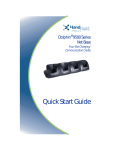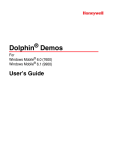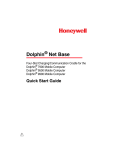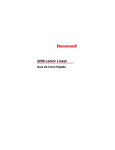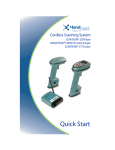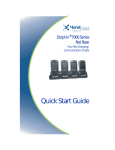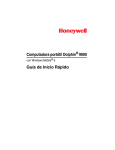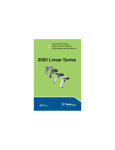Download HandHeld Entertainment Quick Check 890 Scanner User Manual
Transcript
User’s Guide Quick Check® 890 Quick Check ImageData ™ Barcode Verifier Disclaimer Hand Held Products, Inc. (“Hand Held Products”) reserves the right to make changes in specifications and other information contained in this document without prior notice, and the reader should in all cases consult Hand Held Products to determine whether any such changes have been made. The information in this publication does not represent a commitment on the part of Hand Held Products. Hand Held Products shall not be liable for technical or editorial errors or omissions contained herein; nor for incidental or consequential damages resulting from the furnishing, performance, or use of this material. This document contains proprietary information that is protected by copyright. All rights are reserved. No part of this document may be photocopied, reproduced, or translated into another language without the prior written consent of Hand Held Products. ©2007-2008 Hand Held Products, Inc. All rights reserved. Web Address: www.handheld.com Quick Check® is a registered trademark of Hand Held Products, Inc. Windows® and the Windows logo are trademarks or registered trademarks of Microsoft Corporation. The Bluetooth® word mark and logos are owned by Bluetooth SIG, Inc. Note: Software screens included in this document are in English only and are included for reference only. They may be different from the screen that displays on your terminal. Table of Contents Chapter 1 - Getting Started Introduction........................................................................... 1-1 Unpacking the QC890 Verifier............................................. 1-1 QC890 Verifier Features....................................................... 1-1 Using the QC890 Verifier..................................................... 1-2 Scan Button........................................................................... 1-2 Scan Button LEDs.......................................................... 1-2 User LED Indications..................................................... 1-3 Physical Connections............................................................ 1-3 Specifications........................................................................ 1-4 Internal Battery ..................................................................... 1-4 Charging the Battery ...................................................... 1-4 Powering On the QC890 Verifier .................................. 1-4 Chapter 2 - Quick Check ImageData Quick Check ImageData....................................................... 2-1 System Requirements ........................................................... 2-1 Installation of Quick Check ImageData ............................... 2-1 Communication Interfaces.................................................... 2-1 USB Communication Interface ...................................... 2-2 USB COM Port Emulation............................................. 2-2 RS-232 Serial Communication Interface ....................... 2-3 RS-232 Selections .......................................................... 2-3 Bluetooth............................................................................... 2-3 Using the QC890 Verifier with Bluetooth Devices ....... 2-4 Enabling Your Device for Bluetooth.................................... 2-5 Enabling QCID for Bluetooth............................................... 2-6 Using Quick Check ImageData ............................................ 2-7 Help System.......................................................................... 2-8 i Chapter 3 - Using the Quick Check 890 Verifier System Scanning a Barcode Symbol Using the QC890 Verifier ...... 3-1 Scanning a Barcode Symbol Using Quick Check ImageData .................................................... 3-1 Calibrating the QC890 Verifier ............................................ 3-2 Scanning Properly Using a Pen/Mouse Wand...................... 3-3 Calibrating an External Pen/Mouse Wand ........................... 3-4 Scanning Properly Using the QC3800VE Linear Imager: ... 3-5 Calibration Log..................................................................... 3-6 Reflectometer Mode ............................................................. 3-6 Chapter 4 - Maintenance Cleaning the External Devices.............................................. 4-1 QC890 Verifier ..................................................................... 4-1 Recertification....................................................................... 4-1 Chapter 5 - Customer Support Technical Assistance ............................................................ 5-1 Online Technical Assistance .......................................... 5-2 For Further Information ................................................. 5-2 Product Service and Repair .................................................. 5-2 Online Product Service and Repair Assistance.............. 5-3 Limited Warranty.................................................................. 5-3 Appendix A - Apertures Pen/Mouse Wand Aperture Selection...................................A-1 Appendix B - Menu Setting Barcodes Resetting the Standard Product Defaults ..............................B-1 Illumination Timer................................................................B-1 Power Down Timer ..............................................................B-2 Appendix C - Symbology Defaults - Operation ii 1 Getting Started Introduction The Quick Check® 890 Verifier System (QC890) is a professional quality control system for verifying the readability and standards compliance of printed linear barcode symbols. This verification system implements an integrated approach that consists of the QC890 Verifier unit and the Quick Check® ImageData (QCID) software. The QC890 system offers ease of use, stability and repeatability, flexibility, increased user features and control, and quality testing of the most common industry applications and symbologies. Unpacking the QC890 Verifier After you open the shipping carton, take the following steps: • Check for damage during shipment. Report damage immediately to the carrier who delivered the carton. • Make sure the items in the carton match your order. • Save the shipping container for later storage or shipping. The standard accessories that should be included in your kit are: • • • • • • • • • Quick Start Guide CD with QCID software and user documentation DC power supply with cord (includes adapters for different countries) Interface cables (USB and RS-232) Plastic gauge Metal ruler Reference test symbols Reflectance page Certificate of Conformance QC890 Verifier Features The QC890 Verifier is a full-featured barcode verification system compatible with all major linear barcode symbologies. It is both a quick and easy-to-use pass/fail analyzer of barcode symbols and a powerful measuring tool for detailed testing of barcode symbols. The QC890 Verifier provides all of the information you need to interpret overall symbol quality. Quick Check® 890 User’s Guide 1-1 The verifier tests the following symbologies: Codabar Micro PDF417 Code 11 MSI Code 16K PDF417 Code 39 Reduced Space Symbology (RSS-14, RSS Limited, RSS Expanded) Code 49 Regular 2 of 5 Code 93 Straight 2 of 5 IATA Code 128 Telepen Interleaved 2 of 5 UPC/EAN Using the QC890 Verifier The QC890 Verifier offers a choice of Automatic, 3, 5, 6, and 10 mil aperture settings. External devices (i.e., mouse wands, pen wands, and linear imagers) are available with apertures designed to match the most common X dimensions. Wands are available with apertures of 3 (Mouse Wand only), 5, 6, 10, and 20 (Mouse Wand only) mil. These aperture sizes correspond to those specified in ISO/IEC 15416 Barcode Print Quality Test Specification - Linear Symbols. The proper aperture should be selected based on the X dimension range shown in the table in the Pen/Mouse Wand Aperture Selection (page A-1) section. Choosing an inappropriate scanning aperture results in inaccurate quality measures. Too small an aperture may detect reflectance non-uniformities (spots and voids) that would not affect scanning with a "normal" aperture size. Too large an aperture will not be able to resolve individual elements of the symbol. Scan Button The scan button on top of the unit wakes the unit from power down. A first press of the button turns on illumination and a second press activates reading capabilities. Scan Button LEDs • Red LED - error conditions • Green LED - good symbols and configuration changes 1-2 Quick Check® 890 User’s Guide User LED Indications LED Indication Cause Green Solid Green Flash Red Flashing Orange Solid Charging Good read Low battery Battery too low for unit to operate (plug in external power supply) Audio Sound An audio signal (default ON) provides a quick indication if a scan passes or fails the current test. After a scan, one short, high pitch beep indicates that the symbol passes an appropriate group of tests, while one long, low pitch beep indicates that it fails. Special Features Reflectometer Mode In the Reflectometer mode, the QC890 operates as a free-running reflectometer. See "Reflectometer Mode" on page 3-6 for additional information. Unrecognized Symbology Mode The QC890 analyzes bar/space patterns that are not decodable or are not among the unit’s available symbologies. This technical feature is useful for making contrast measurements, for which decoding is not necessary, on damaged or partial symbols, printer test patterns, and new or developing symbologies. We recommend this feature only be enabled for these purposes. Physical Connections A DC power barrel on the back of the unit connects to a power supply for external power and battery charging. The DB9 port on the unit connects to the pen wand, mouse wand, or linear imager. Refer to "Scanning Properly Using the QC3800VE Linear Imager:" on page 3-5. If you are using any of these devices, refer to "Scanning Properly Using a Pen/Mouse Wand" on page 3-3 for additional information. The RJ45 ten pin connector provides the USB or RS-232 serial interface to the host. Refer to "USB Communication Interface" on page 2-2 and "RS-232 Serial Communication Interface" on page 2-3 for details on connecting your unit. Quick Check® 890 User’s Guide 1-3 Specifications Item Specification Dimensions 7” (18cm)W x 6”(15.cm)H x 5.4” (14cm)D Weight 1 lb 8 oz (680 grams) Temperature Storage: -20° to 70°C Operational: 0° to 50°C Humidity 20% to 95% RH non condensing Battery Built-in factory - Lithium Ion rechargeable Internal Battery The battery is factory replaceable only. You must return your unit to Hand Held Products for replacement (see Technical Assistance on page 5-1). Charging the Battery The battery may be in an unknown charge state at delivery. We recommend that you charge the battery for at least 2 hours prior to use. You may use the unit while charging the battery. To charge the battery: 1. Plug the power supply into the port on the back of the unit. 2. Plug in the power supply to the AC main source. The QC890 Verifier uses a rechargeable battery. The QC890 Verifier can be operated from the battery or power supply. With a properly charged battery, the unit operates for a minimum of 8 hours. When not in use, you can leave the unit connected to the charger. Powering On the QC890 Verifier • If the power supply is attached and plugged into an AC source, the QC890 Verifier is on. • If the QC890 Verifier is attached to the USB host with power on, the verifier is on. • If the QC890 Verifier is operating using the battery, it shuts itself off after 15 minutes of inactivity to conserve battery power. Pressing the scan button on top of the unit one time powers up the unit from the power down mode. 1-4 Quick Check® 890 User’s Guide 2 Quick Check ImageData Quick Check ImageData The Quick Check ImageData (QCID) program was designed for use in conjunction with the QC890 Verifier. Use of any other hardware devices with this program is not supported. Installation of the QCID software for your appropriate operating system is included on the CD-ROM that accompanied your verifier. The QCID is the graphical interface to the Quick Check 890 Verifier. The verification results can be saved for later reference. System Requirements Windows: • • • • • • • Microsoft Windows 98 Second Edition, 2000, Windows NT 4.0 or XP operating system Pentium 100Mhz (recommend 500Mhz and up) 64 MB RAM (recommended 128 MB and above) Application: 5 MB available hard disk space .NET framework: 110 MB of hard disk space required, 40 MB additional hard disk space required for installation (150 MB total) Any available COM or USB port or Bluetooth (supports SPP profiles) Microsoft compatible mouse Windows Mobile 2003: • • • • • Windows CE .NET 4.2 or Pocket PC 2003/2003 SE ARM4 processor 64 MB RAM (2MB RAM for the application) Any available COM port, Bluetooth (supports SPP profiles) Win 5.0 minimum 10mb Installation of Quick Check ImageData To install the Quick Check ImageData, insert the CD and follow the instructions that appear. Communication Interfaces The QC890 Verifier system supports the following interfaces: USB, RS-232, and Bluetooth®. Quick Check® 890 User’s Guide 2-1 USB Communication Interface For the USB interface, the Hand Held Products CDC-ACM driver must be installed prior to using the QC890 Verifier. This driver is copied to the following directory during install: <install location>\Drivers\USBCOMPortEmulation/hhpcdc.inf The default <install location> is C:\Program Files\Hand Held Products\Quick Check ImageData\drivers\USBCOMPortEmulation. ! Review the file, readme.rtf, in the install location prior to running the QCID. Connect the QC890 Verifier to the host as shown in the illustration below. 1 2 USB COM Port Emulation Scan the following barcode to program the QC890 Verifier to emulate an RS232-based COM Port. After connecting the QC890 Verifier and upon successful installation of the USB driver, the driver will use the next available COM Port. USB COM Port Emulation is the default interface for the QC890 Verifier. * USB COM Port Emulation Note: No additional configuration (e.g., baud rate) is necessary. 2-2 Quick Check® 890 User’s Guide RS-232 Serial Communication Interface An RS-232 interface requires no additional drivers. Connect the QC890 Verifier to the host as shown in the illustration below. RS-232 Selections Scan the following barcode to select RS-232 communications. RS-232 Communication The RS-232 settings supported are: Baud Rate: 115,200 Parity: None Data Bits: 8 Stop Bits: 1 Flow Control: None Bluetooth Bluetooth implementation uses SPP (Serial Port Profile) to connect the QC890 Verifier to the host system. The QC890 SPP is a standard Bluetooth profile implementation. This allows the QC890 system to be compatible with most Bluetooth devices. The QC890 unit can be used with existing Bluetooth radios built into laptops, PCs, or PDAs. Quick Check® 890 User’s Guide 2-3 Using the QC890 Verifier with Bluetooth Devices Note: When using USB or RS-232 interfaces, the Bluetooth communication interface automatically turns off. Scan the Bluetooth barcode below to enable the Bluetooth option. Default = Off. Bluetooth On Once the Bluetooth option is enabled, scan the appropriate barcode that follows to connect to a PC or laptop, or a PDA/Mobility Systems device. To establish a Bluetooth connection to a PC or a laptop, scan the barcode below, follow the instructions supplied with your Bluetooth device to locate the QC890 Verifier, and connect to it. If you go out of range with your QC890 Verifier, the QC890 Verifier automatically reconnects to the Bluetooth device once you come back in range. When Bluetooth communication is enabled, the default is PC/ Laptop. * Bluetooth Connection - PC/Laptop To establish a Bluetooth connection to a PDA or a Hand Held Products Mobility Systems device, scan the barcode below, follow the instructions supplied with your Bluetooth device to locate the QC890 Verifier, and connect to it. If you go out of range with your QC890 Verifier, the QC890 Verifier will not reconnect. It will be up to the host device to reconnect to the QC890 Verifier. Bluetooth Connection - PDA/Mobility Systems Device 2-4 Quick Check® 890 User’s Guide Enabling Your Device for Bluetooth After scanning the appropriate Bluetooth connection barcode, you need to run the Quick Check ImageData application to enable the Bluetooth radio in your device (PC, PDA, or Mobility Systems device) in order to look for the QC890 Verifier. Once the QC890 Verifier is recognized, it appears in the list of available devices. Select the QC890 Verifier to which you want to bond and select Next. Quick Check® 890 User’s Guide 2-5 You will be asked if you need a passkey to add your device. The default passkey for all Hand Held Products QC890 verifiers is “1234.” The Wizard loads the QC890 Verifier information into your device. You may click a checkbox to indicate the QC890 Verifier is the default device to which Quick Check ImageData connects. Once you select Finish, your device is ready to communicate with the QC890 Verifier via the assigned ports. Make a note of the assigned port number. You will need to know this port number in the following installation steps. Enabling QCID for Bluetooth 1. Once you open the QCID application, click on File -> Preferences. 2. Choose the assigned incoming port number reported in the Add Bluetooth Device wizard and click OK. 3. Your QC890 Verifier connects to the QCID application. 2-6 Quick Check® 890 User’s Guide Using Quick Check ImageData For the PC version of Quick Check ImageData, start Quick Check ImageData by clicking on Start->Programs->Hand Held Products->Quick Check ImageData or double click the Quick Check ImageData icon on your desktop (set up during installation). For the PDA version, start Quick Check ImageData by clicking on Start ->Programs. Select the Quick Check ImageData icon. The first time you use QCID, the application asks you to select the COM Port to which the QCID is attached. After you make the selection, QCID attempts to connect to the attached QC890 Verifier. When a connection is established, the main screen of the application, as shown below, displays. PC Main Screen Quick Check® 890 User’s Guide 2-7 PDA Main Screen Help System The Quick Check ImageData program has an extensive help system to aid in the verification of your barcodes. Please refer to the help files for questions regarding the verification process and for specific questions regarding the QCID program. 2-8 Quick Check® 890 User’s Guide 3 Using the Quick Check 890 Verifier System Scanning a Barcode Symbol Using the QC890 Verifier ! Calibration is a requirement of the ISO/IEC standards. Without proper initial calibration, the values displayed may not be accurate. Please be sure to calibrate the QC890 Verifier prior to scanning barcodes and when you change apertures and/or external scanning devices. 1. Place the QC890 Verifier on top of the symbol. 2. Press the scan button on top of the unit to turn on illumination. Look through the unit’s window to align the unit with the barcode. Note: The best verification data is gathered by aligning the center of the symbol to the center arrows. 3. Press the scan button on top of the unit again while the illumination is on to scan and verify the barcode. 4. To scan PDF417 barcodes, hold the scan button down and move the verifier up and down so the aiming line sweeps from the top of the bar code to the bottom, and back up. This ensures that the entire code is scanned. Scanning a Barcode Symbol Using Quick Check ImageData 1. Place the QC890 Verifier on top of the symbol. 2. If necessary, press the scan button on top of the unit to turn on illumination to aid in alignment of the symbol. 3. For the PC version, click the Scan button on the Main Display window. Quick Check® 890 User’s Guide 3-1 4. For the PDA version, select Device and then Scan from the Scan Data tab. Calibrating the QC890 Verifier ! Calibration is a requirement of the ISO/IEC standards and must be performed with each aperture change. When calibrating the QC890 Verifier system, the QC890 Verifier must be connected to the Quick Check ImageData software. During calibration, it is important to align the center of the barcode symbol to the center arrows, and keep the QC890 Verifier flat and level to the surface of the reflectance page. The reflectance page is a precision standard that is made of photographic materials. To ensure proper calibration, you must replace the reflectance page if it becomes dirty or physically damaged. Make sure to use only the original calibration tools that were supplied with your QC890 Verifier kit or certified replacements obtained from Hand Held Products. 1. Place the verifier on top of the reflectance page. Use the symbol alignment window to center the reflectance page. 2. Press the scan button on top of the unit to turn on illumination to aid in alignment. Note: The best calibration is performed by aligning the center of the symbol to the center arrows. 3. Press the scan button on top of the unit a second time while the illumination is on to scan the calibration barcode. You will hear a series of beeps and the 3-2 Quick Check® 890 User’s Guide illumination will turn off. If the calibration process is successful, the following screen displays: 4. Enter your name and the location where the calibration was performed and click on OK. The following screen displays: 5. If the unit does not calibrate, contact Hand Held Products Technical Support (see Technical Assistance on page 5-1). To access calibration logs, go to Settings->Calibration->Calibration Log. Enter the password visions07. Scanning Properly Using a Pen/Mouse Wand Note: It is important to perform reflectance calibration prior to using any pen or mouse wand. See "Calibrating an External Pen/Mouse Wand" on page 3-4. 1. Turn on the verifier and confirm that the pen/mouse wand is securely connected. 2. Hold the pen wand as you would a pen or pencil, placing your fingers on each side of the foot near the tip: or Quick Check® 890 User’s Guide 3-3 Hold the mouse wand horizontally so it moves across the barcode in the direction of the arrows: 3. Lightly touch the wand against either quiet zone (clear area) on either side of the barcode. For the pen wand, you will have the proper scanning angle when the tip and the reflectance guide (black plastic clamp) are flat on the scanning surface. 4. At about the same speed with which you would quickly underline a sentence in this manual, and without interruption, gently move the wand across the center of the barcode. You do not need to press hard on the wand while scanning the barcode. Gentle pressure on the wand will not scratch the contacted surface, but pressing down hard may damage the code and yield poor results. 5. Listen for audible tones. • • If you hear a single beep tone followed by another single beep of the same tone, it signifies a good read. If you hear a single beep and then a beep of a different tone, the unit detected an error in the scanned symbol. Calibrating an External Pen/Mouse Wand 1. Using the proper scan technique described in step 4 above, scan the reflectance page. You will hear a single beep after the first good scan and the following display appears: 2. Continue to scan the reflectance page for a total of 10 good scans. After each good scan, a single beep sounds and the display indicates the number 3-4 Quick Check® 890 User’s Guide of good scans you need to obtain. After the tenth good scan, the following window displays: 3. After you type in your name and location, click OK. The following message appears: Note: When using the external QC3800VE linear imager, it does not report ISO/ IEC reflectance parameters; therefore no calibration is necessary or possible. Scanning Properly Using the QC3800VE Linear Imager: 1. The best reading position for the QC3800VE linear imager is 6 inches (150mm) from the surface of the barcode to the face of the scanner, with an angle of incidence of 15 degrees from perpendicular. At this orientation, the system performance approximates an average circular aperture size of .006 to .008 inches (.152 to .203 mm). Extreme variations from this orientation may negatively affect the accuracy of some parameter results. 2. Scanning is initiated by squeezing the trigger on the linear imager. Hold the trigger down until the beam shuts off. 3. Listen for an audible tone. When the unit scans and decodes a barcode, it emits a single beep. • If the unit cannot decode a barcode after a trigger pull, it will not beep and no results are displayed. • After a successful decode, with a result that passes the minimum acceptable grade, the unit emits another beep of the same tone. • A decode that fails to receive a grade above the minimum requirement causes the unit to emit a beep of a different tone. Note: The QC3800VE reading width (includes quiet zones) is 6 inches. The QC3800VE is the only device that can be used as a non-contact input device with a QC890 Verifier unit. The QC3800VE should not be used with any decoders, terminals, or other brand of verifiers. Quick Check® 890 User’s Guide 3-5 Calibration Log The Calibration Log records the instances when reflectance calibration was performed. It records the Date/Time set on your PC, serial number of the QC890 Verifier being calibrated, and the name and location of the operator. To access the Calibration Log, click on Settings -> Calibration -> Calibration Log. You will be prompted to enter a password. The password can be either the Master Password (visions07) or a password you previously set. The Calibration Log looks like this: Reflectometer Mode Note: The Reflectometer Mode is only available for use with the mouse/pen wands. It is important to perform reflectance calibration prior to using any pen or mouse wand. Reflectometer Mode measures the spot reflectance of the area at which the imager is “looking.” 3-6 Quick Check® 890 User’s Guide 1. To activate the Reflectometer, click on the Reflectometer icon ( ) on the tool bar below the menu options. The Reflectometer window opens. 2. Place the scanning device on any surface to see the spot reflectance of that surface. The green status bars shows the reflectance signal strength. The field to the right of the status bar shows the percentage of reflectance. 3. Select OK to exit the Reflectometer mode. Quick Check® 890 User’s Guide 3-7 3-8 Quick Check® 890 User’s Guide 4 Maintenance Cleaning the External Devices Occasionally the scanner tip or window may become partially obstructed by ink, paper fibers, or other particulate deposits (such as wax or varnish). To ensure reliable scanning, you should periodically check and, if necessary, clean the tip with a soft cloth. Damaged tips for the pen wand should be replaced. Consult your dealer or Hand Held Products Product Service and Repair Department for details (see Technical Assistance on page 5-1). QC890 Verifier Occasionally the view window or alignment window may become dusty or dirty. Use a soft cloth to clean both windows. Since the open slot of the alignment window is where the code is “seen,” dirt on the window does not affect the readability of the QC890 Verifier. It is not necessary or advisable to insert anything into the open slot on the bottom of the QC890 Verifier. Recertification Sending the QC890 Verifier back to Hand Held Products periodically for a factory calibration and re-certification is recommended, however the frequency is based on your company’s ISO procedures regarding test and measurement equipment. When you are ready to re-certify your QC890 Verifier, please contact Product Service and Repair for pricing and a Return Material Authorization (RMA) number (see Technical Assistance on page 5-1). Quick Check® 890 User’s Guide 4-1 4-2 Quick Check® 890 User’s Guide 5 Customer Support Technical Assistance If you need assistance installing or troubleshooting, please call your Distributor or the nearest Hand Held Products technical support office: North America/Canada Telephone: (800) 782-4263 Fax number: (315) 554-6705 E-mail: [email protected] Latin America Telephone: (803) 835-8000 Telephone: (800) 782-4263 E-mail: [email protected] Brazil Telephone: +55 (21) 3535-9100 Fax: +55 (21) 3535-9105 E-mail: [email protected] Mexico Telephone: (803) 835-8000 E-mail: [email protected] Europe, Middle East, and Africa Telephone: +31 (0) 40 7999 393 Fax: +31 (0) 40 2425 672 E-mail: [email protected] Asia Pacific Telephone - Hong Kong: +852-3188-3485 or 2511-3050 Telephone - China: +86 21 6361 3818 E-mail: [email protected] Japan Telephone: +813 5770-6312 E-mail: [email protected] Malaysia Telephone: +603-6201-7020 E-mail: [email protected] Quick Check® 890 User’s Guide 5-1 Online Technical Assistance You can also access technical assistance online at www.handheld.com. For Further Information To download the full User’s Guide for these products, visit our website at www.handheld.com. Product Service and Repair Hand Held Products provides service for all its products through service centers throughout the world. To obtain warranty or non-warranty service, return the unit to Hand Held Products (postage paid) with a copy of the dated purchase record attached. Contact the appropriate location below to obtain a Return Material Authorization number (RMA #) before returning the product. North America Telephone: (800) 782-4263 Fax: (803) 835-8012 E-mail: [email protected] Latin America Telephone: (803) 835-8000 Telephone: (800) 782-4263 Fax: (239) 263-9689 E-mail: [email protected] Brazil Telephone: +55 (21) 3535-9100 Fax: +55 (21) 3535-9105 E-mail: [email protected] Mexico Telephone: +52 (55) 5203-2100 Fax: +52 (55) 5531-3672 E-mail: [email protected] Europe, Middle East, and Africa Telephone: +31 (0) 40 2901 633 Fax: +31 (0) 40 2901 631 E-mail: [email protected] Asia Pacific Telephone: +852-2511-3050 Fax: +852-2511-3557 E-mail: [email protected] 5-2 Quick Check® 890 User’s Guide Japan Telephone: +813-5770-6312 Fax: +813-5770-6313 E-mail: [email protected] Online Product Service and Repair Assistance You can also access product service and repair assistance online at www.handheld.com. Limited Warranty Hand Held Products, Inc. ("Hand Held Products") warrants its products to be free from defects in materials and workmanship and to conform to Hand Held Products’ published specifications applicable to the products purchased at the time of shipment. This warranty does not cover any Hand Held Products product which is (i) improperly installed or used; (ii) damaged by accident or negligence, including failure to follow the proper maintenance, service, and cleaning schedule; or (iii) damaged as a result of (A) modification or alteration by the purchaser or other party, (B) excessive voltage or current supplied to or drawn from the interface connections, (C) static electricity or electro-static discharge, (D) operation under conditions beyond the specified operating parameters, or (E) repair or service of the product by anyone other than Hand Held Products or its authorized representatives. This warranty shall extend from the time of shipment for the duration published by Hand Held Products for the product at the time of purchase ("Warranty Period"). Any defective product must be returned (at purchaser’s expense) during the Warranty Period to Hand Held Products’ factory or authorized service center for inspection. No product will be accepted by Hand Held Products without a Return Materials Authorization, which may be obtained by contacting Hand Held Products. In the event that the product is returned to Hand Held Products or its authorized service center within the Warranty Period and Hand Held Products determines to its satisfaction that the product is defective due to defects in materials or workmanship, Hand Held Products, at its sole option, will either repair or replace the product without charge, except for return shipping to Hand Held Products. EXCEPT AS MAY BE OTHERWISE PROVIDED BY APPLICABLE LAW, THE FOREGOING WARRANTY IS IN LIEU OF ALL OTHER COVENANTS OR WARRANTIES, EITHER EXPRESSED OR IMPLIED, ORAL OR WRITTEN, INCLUDING, WITHOUT LIMITATION, ANY IMPLIED WARRANTIES OF MERCHANTABILITY OR FITNESS FOR A PARTICULAR PURPOSE. HAND HELD PRODUCTS’ RESPONSIBILITY AND PURCHASER’S EXCLUSIVE REMEDY UNDER THIS WARRANTY IS LIMITED TO THE REPAIR OR REPLACEMENT OF THE DEFECTIVE PRODUCT. IN NO EVENT SHALL HAND HELD PRODUCTS BE LIABLE FOR INDIRECT, INCIDENTAL, OR CONSEQUENTIAL DAMAGES, AND, IN NO EVENT, SHALL ANY LIABILITY OF HAND HELD PRODUCTS ARISING IN CONNECTION WITH Quick Check® 890 User’s Guide 5-3 ANY PRODUCT SOLD HEREUNDER (WHETHER SUCH LIABILITY ARISES FROM A CLAIM BASED ON CONTRACT, WARRANTY, TORT, OR OTHERWISE) EXCEED THE ACTUAL AMOUNT PAID TO HAND HELD PRODUCTS FOR THE PRODUCT. THESE LIMITATIONS ON LIABILITY SHALL REMAIN IN FULL FORCE AND EFFECT EVEN WHEN HAND HELD PRODUCTS MAY HAVE BEEN ADVISED OF THE POSSIBILITY OF SUCH INJURIES, LOSSES, OR DAMAGES. SOME STATES, PROVINCES, OR COUNTRIES DO NOT ALLOW THE EXCLUSION OR LIMITATIONS OF INCIDENTAL OR CONSEQUENTIAL DAMAGES, SO THE ABOVE LIMITATION OR EXCLUSION MAY NOT APPLY TO YOU. All provisions of this Limited Warranty are separate and severable, which means that if any provision is held invalid and unenforceable, such determination shall not affect the validity of enforceability of the other provisions hereof. Use of any peripherals not manufactured/sold by Hand Held Products voids the warranty. This includes but is not limited to: cables, power supplies, cradles, and docking stations. Hand Held Products, Inc. extends these warranties only to the first endusers of the products. These warranties are nontransferable. The limited duration of the warranty for the Quick Check 890 Verifier is for two (2) years. 5-4 Quick Check® 890 User’s Guide A Apertures Pen/Mouse Wand Aperture Selection The table below is a handy reference to help you choose the proper aperture size required for the size/type barcode you wish to verify. This data is based on the standard ISO/IEC 15416 Barcode Print Quality Test Specification - Linear Symbols. Aperture Diameter (in .001”)/Aperture Ref. No. Aperture Diameter (in mm) "X" Dimension Range (in inches) 03 0,075 0.004 to 0.007 0,102 to 0,178 05 0,125 0.0071 to .013 ,0180 to 0,330 "X" Dimension Range (in mm) 10 0,250 0.0131 to 0.025 0,333 to 0,635 20 0,500 0.0251 and larger 0,637 and larger Note: 6 mil aperture specified for UPC/EAN and RSS. 3 mil and 20 mil aperture available in mouse wand style only. Check your application standard's requirements for specified aperture requirements. If no aperture is specified, use the aperture that is close to, but not larger than, 80% of the narrow element width. The QC890 Verifier has an Automatic selection feature available ONLY for the internal optics. When using the Automatic selection feature, the verifier automatically selects from a 3, 5, 6, or 10 mil aperture. This selection is determined by the symbology (e.g., EAN/UPC selects 6 mil aperture) or as determine by the internal optics’ ability to calculate the width of the narrow element and select the aperture as determined by the table above. Quick Check® 890 User’s Guide A-1 A-2 Quick Check® 890 User’s Guide B Menu Setting Barcodes The QC890 barcode verifiers are programmed in the factory for the most common settings. If you need to change these settings, programming is accomplished by scanning the barcodes included in this chapter. An asterisk (*) next to an option indicates the default setting. Resetting the Standard Product Defaults If you aren’t sure what programming options are in your device, or you’ve changed some options and want the factory settings restored, scan the Standard Product Default Settings barcode below. Standard Product Default Settings Illumination Timer Scan the appropriate barcode to set the duration (in seconds) of the illumination. Default = 5 seconds. 3 seconds *5 seconds 15 seconds Quick Check® 890 User’s Guide B-1 Power Down Timer Note: This option applies to battery operation only. When there is no activity within a specified time period, the QC890 Verifier powers down. Scan the appropriate Power Time-Out barcode to change the time-out duration (in seconds). If there are no scans during the “scanner power time-out timer” interval, the QC890 Verifier goes into power down mode. Whenever a scan occurs, the “scanner power down timer” is reset. Default = 15 minutes No Power Down Timeout 5 minutes *15 minutes 60 minutes 120 minutes B-2 Quick Check® 890 User’s Guide C Symbology Defaults - Operation The default QC890 symbologies and operation are listed below: • Codabar* • Micro PDF417*** • Code 11** • MSI*** • Code 16K*** • PDF417*** • Code 39* • IATA 2 of 5*** • Code 49*** • Regular 2 of 5*** • Code 93* • Telepen** • Code 128* • UPC/EAN* • RSS (RSS-14, RSS Limited, RSS Expanded)*** • Unrecognized*** • Interleaved 2 of 5* • Reverse Video*** * Enabled by default. Can be scanned when disabled. ** Disabled by default. Can be scanned when disabled. *** Disabled by default. Cannot be scanned when disabled. Quick Check® 890 User’s Guide C-1 C-2 Quick Check® 890 User’s Guide Hand Held Products, Inc. 700 Visions Drive P.O. Box 208 Skaneateles Falls, NY 13153-0208 QC890-UG Rev C 1/08








































